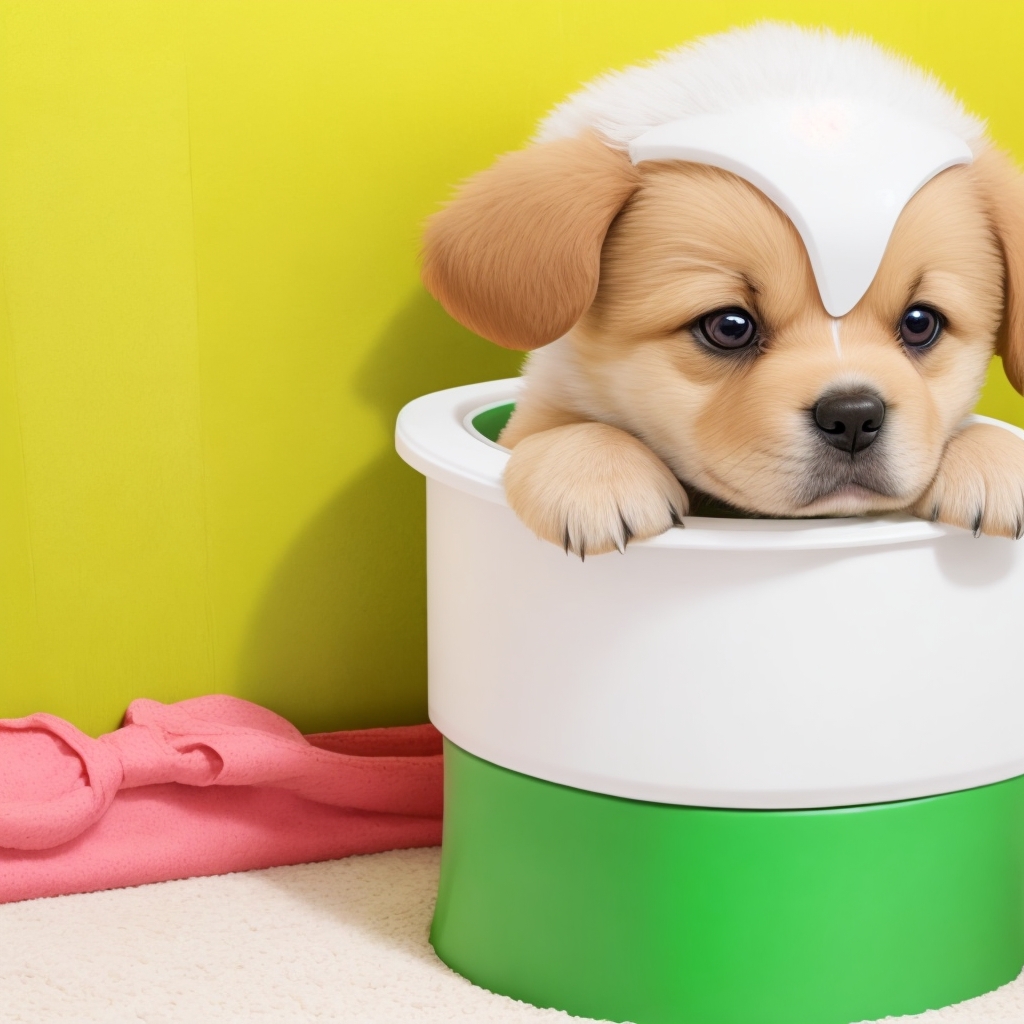Table of Contents
Puppy Training is a thrilling journey, filled with bonding moments, growth, and occasional mischief. Among the essential tasks in this journey, potty training stands out as a pivotal milestone. Establishing a potty routine not only ensures cleanliness but also fosters discipline and understanding between you and your furry friend. The art of potty training is much more than just cleanliness; it’s about creating a seamless bond of trust and communication with your young canine. From the first time they look up at you with those puppy eyes to the day they’ve mastered their routine, the puppy training journey is one of mutual growth and understanding.
Take advantage of your Puppy Development
Puppies, like human toddlers, grow and learn at a remarkable pace. Every whimper, tail wag, and bounce is a part of their ongoing journey of discovery. A crucial aspect of this journey is understanding their developmental stages, which can vastly influence their potty training. Just as a child learns to walk and talk over time, puppies too have their own growth trajectory. Their physical abilities, mental acuity, and even emotional states evolve, all of which play a role in how and when they learn best.
Importance of Bladder Control During Puppy Training
An eight-week-old puppy is a bundle of joy, but its bladder control is still in its infancy. This means that they can’t “hold it” for extended periods. As they grow, usually by the age of 16 weeks, their bladder control improves. However, accidents will happen in the interim. Imagine a toddler learning to use the potty; they’re bound to have a few mishaps along the way. Similarly, a young pup requires patience, understanding, and consistent guidance during this phase.
 Use their Natural Instincts in the Training
Use their Natural Instincts in the Training
Contrary to the challenges posed by their bladder control, puppies have an innate instinct to keep their sleeping and living areas clean. This behavior traces back to their wild ancestors, who maintained clean dens to avoid attracting predators. By tapping into this natural instinct, you can create a supportive environment that encourages your puppy to potty in designated areas. Recognizing and leveraging this behavior during your Puppy training is like finding a cheat code for the potty training game. It streamlines the process, aligning it with the puppy’s inherent inclinations.
Necessary Tools for Your Puppy Training
The old adage, “A craftsman is only as good as his tools,” rings true even in potty training. Key supplies like puppy pads, treats for reinforcement, a consistent feeding schedule, and an enzymatic cleaner for accidents can make a world of difference. Think of these tools as your training kit. Without them, the process can become significantly more challenging and less effective. Being well-equipped not only facilitates training but also boosts your confidence, making the process smoother for both you and your pup.
Setting Up a Designated Potty Area
Much like humans have bathrooms, puppies need a designated “potty area.” This consistency helps them recognize and remember where they need to go. It’s more than just a spot in the yard; it’s their personal space, devoid of distractions. Over time, this specific area becomes a familiar spot for them, making them more comfortable and reducing accidents elsewhere.
The Puppy Training Process
-
Consistency and Routine
Routine is to puppies what schedules are to humans. Just as we thrive on a set routine, be it our morning coffee or nightly news recap, puppies too find comfort in predictability. Feeding, playtime, naptime, and of course, potty breaks, when consistent, form a rhythm that the puppy begins to understand and follow. A well-structured day can significantly reduce the uncertainty and anxiety that might lead to accidents.
-
Positive Reinforcement
Every achievement, no matter how small, deserves recognition. When your puppy gets it right, showering them with praise, affection, or treats reinforces the positive behavior. Think back to when you were a child; didn’t the promise of a reward always make tasks more appealing? The same psychology works for puppies. Positive reinforcement not only speeds up the training process but also strengthens the bond between the pup and the owner.
-
Handling Accidents
No journey is without its bumps, and in potty training, these bumps often come in the form of little puddles or piles. Reacting negatively or punishing the puppy can do more harm than good. Instead, a calm demeanor, coupled with redirecting them to the right spot, is the way to go. Clean up promptly, ensuring no lingering scents, as puppies have a knack for returning to the scene of the “crime” due to residual smells.
Common Puppy Training Challenges
-
Dealing with Night-time Accidents
The moonlit hours can pose a unique set of challenges. Young pups, especially, might find it hard to “hold it in” throughout the night. Their developing bladders, combined with a deep sleep cycle, can lead to night-time accidents. To mitigate this, consider a late-night potty break before bedtime. Think of it as the puppy equivalent of a late-night bathroom trip for toddlers; it’s essential and can prevent potential mishaps.
-
Distractions and Interruptions
In the curious world of a puppy, every leaf, insect, or gust of wind can be a fascinating distraction. This curiosity, while endearing, can sometimes interrupt their potty routine. If your puppy gets sidetracked by the wonders of the outdoors during potty time, a gentle nudge or redirection can help them refocus. Remember, their world is filled with new sights, sounds, and smells every day; it’s our job to guide them through it.
-
Adapting to Changes during the Training
As with any training, there might be times when you need to adapt. Changes in the environment, schedule, or even dietary shifts can affect a puppy’s potty routine. Being adaptable and observant ensures that you can tweak the training process as required, ensuring continued success. Puppies, like us, have their good days and off days. Recognizing and adapting to their changing needs is the hallmark of a responsive trainer.
-
Celebrating Milestones
Every accident-free day, every time they head to the designated spot without a prompt, is a milestone. Celebrate these moments. They signify progress, growth, and understanding. It’s not just about a well-trained puppy; it’s about the journey you undertake together, relishing the highs and navigating the lows.
Potty training, while seemingly a straightforward task, is a complex interplay of patience, understanding, consistency, and mutual growth. It’s not just about teaching a puppy where to relieve themselves; it’s about laying the foundation for a lifetime of understanding and companionship. As with any profound puppy training journey, there will be moments of joy, occasional setbacks, and invaluable lessons. But with the right approach, tools, and mindset, the path to a fully potty-trained pup is not only achievable but also incredibly rewarding.
FAQs
How long does it typically take to potty train a puppy?
Every puppy is different, but with consistent training, many can be trained in 4-6 months.
What if my puppy seems afraid of going outside?
How long does it typically take to potty train a puppy?
Every puppy is different, but with consistent training, many can be trained in 4-6 months.
What if my puppy seems afraid of going outside?
It might be due to unfamiliar sounds or surroundings. Gradually introduce them to the outdoors, preferably during quieter times, and reward them with treats and praise to build confidence. If these do not work, see a veterinary for its mental and overall health.
Can an 8-week old puppy be potty trained?
While an 8-week old puppy can begin the process, complete potty training takes time due to their limited bladder control. However, early introduction can set the foundation for success.
How do you potty train a puppy fast?
Consistency, positive reinforcement, a regular schedule, and immediate correction during accidents are keys to faster potty training.
How old should a puppy be fully potty trained?
Most puppies can be fully potty trained between 4 to 6 months, though some breeds might take longer.
How old should a puppy be to start training?
You can start basic training like “sit,” “stay,” and “come” as early as 7-8 weeks.
What age is too late to train a puppy?
It’s never too late! Older dogs can be trained, but starting early often makes the process smoother.
What are the 5 commands for puppy training?
The fundamental five are “Sit,” “Stay,” “Come,” “Down,” and “Heel.”
What are some golden rules of dog training?
Be consistent, use positive reinforcement, start with short sessions, be patient, and always end training on a positive note.
What dog breeds are hardest to potty train?
Breeds like Dachshunds, Bichon Frises, and Yorkshire Terriers can sometimes be more challenging to potty train due to their stubborn nature.
What is a good schedule for an 8-week old puppy?
Regular feeding times, frequent potty breaks (especially after meals), short training sessions, playtime, and nap time.
What is the best age to train a puppy?
Start as early as 7-8 weeks for basic commands. However, formal training classes usually begin around 12 weeks.
What is the best way to train a puppy?
Positive reinforcement, consistency, and patience. It’s also beneficial to attend puppy training classes for structured guidance.
What should I start teaching my puppy?
Begin with the basics: housebreaking, name recognition, and the five fundamental commands (“Sit,” “Stay,” “Come,” “Down,” and “Heel”).



